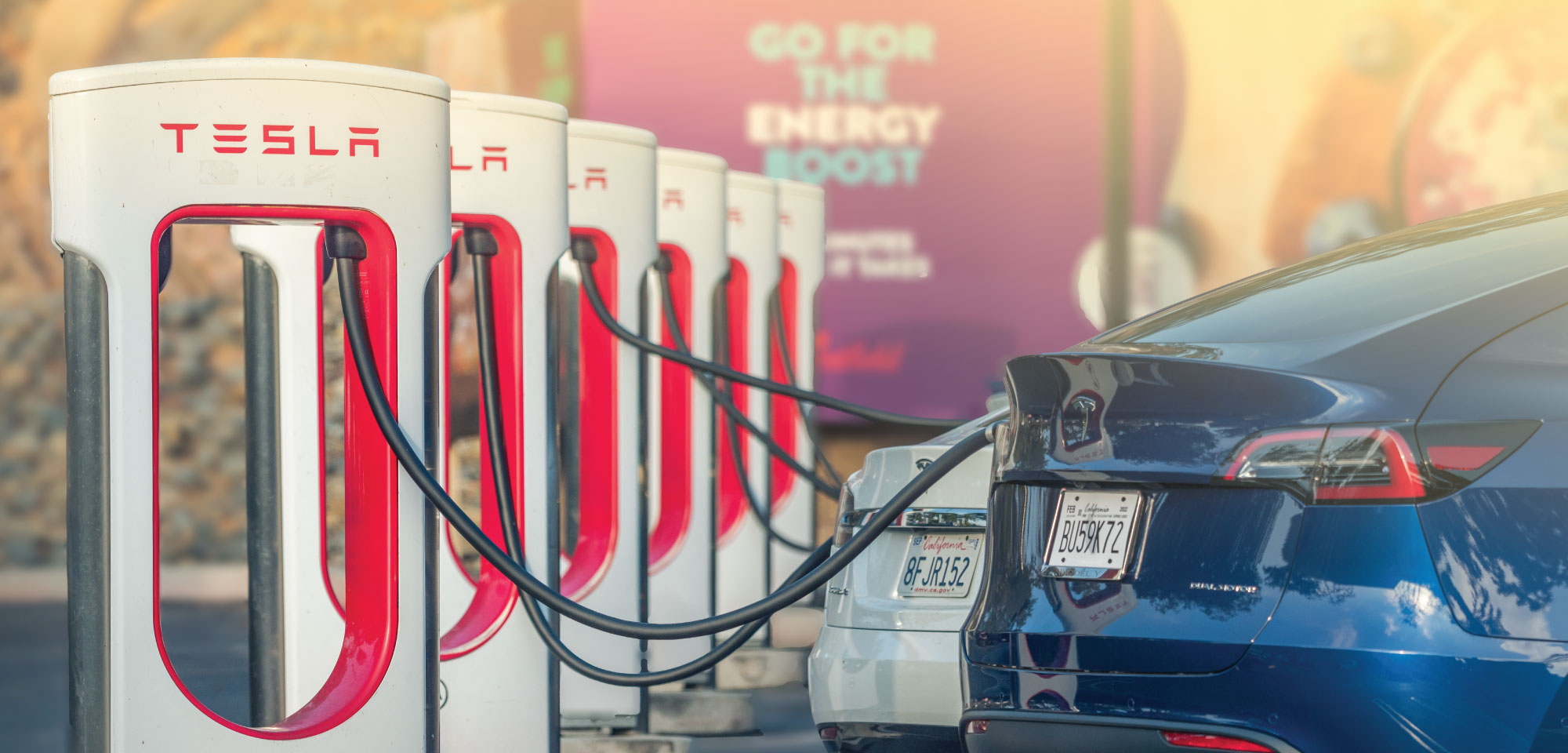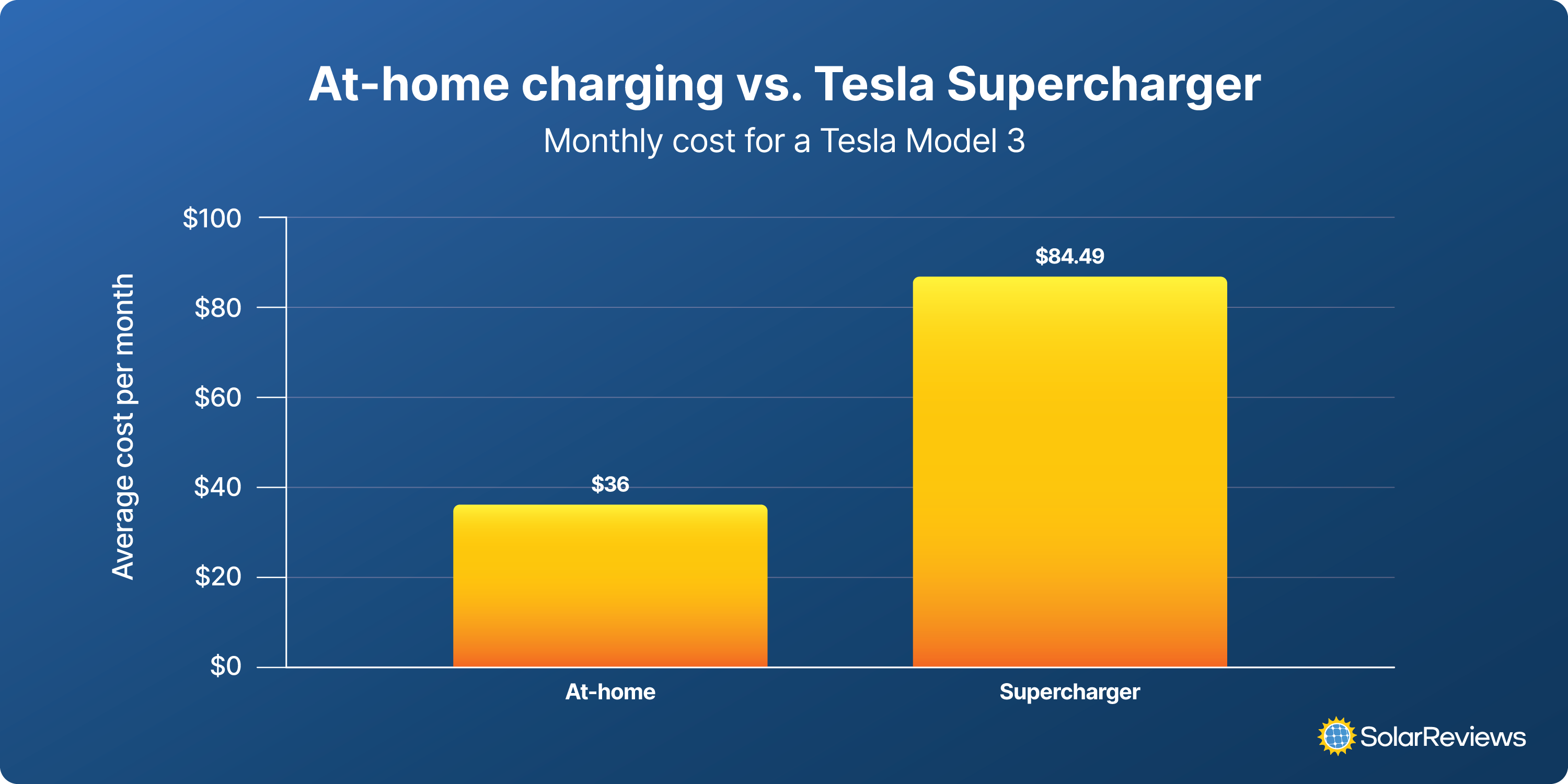Updated 1 year ago
Tesla Supercharger Cost: Is It Cheaper Than Gas?
Written by
Jamie Smith

Find out how much it costs to charge a Tesla with solar panels
Key takeaways
-
You can expect to pay between $6 and $50 to fully charge your Tesla at a Supercharger station, excluding any fees.
-
Superchargers have an average rate of $0.25 per kilowatt-hour, but rates vary between locations.
-
The total cost to charge your Tesla using the Supercharger network will vary depending on your Tesla model and the electricity rate offered at the station.
-
A Supercharger can give your Tesla up to 200 miles of range in as little as 15 minutes.
-
The cheapest method of charging your Tesla is with home solar panels, costing $0.06 per kWh.
Teslas are some of the most popular electric vehicles on the market. Aside from their relatively low pricing and brand recognition, one of the biggest benefits of owning a Tesla is having access to its extensive Supercharger charging network.
Also known as DC fast chargers, Superchargers are EV charging stations that give your Tesla 200 miles of range in as little as 15 minutes while on the go. You can expect to pay between $6 and $50 to charge using a Supercharger, but the total cost will vary depending on the charging rates, fees, and more.
In this article, we’ll pull back the curtain on Tesla’s fast chargers so you can better understand how they work and the cost of charging with a Supercharger.
How much does it cost to charge a Tesla at a Supercharger?
In 2025, you can expect to pay about $27 on average to fully charge your Tesla at a Supercharge station, excluding any fees. But, depending on the rates at the Supercharger and the car you have, it could reach almost $60 for one charging session.
Yes – that’s a pretty big price range. Supercharger rates vary quite a bit by location and even by the time of day at some stations. Tesla enthusiasts on Reddit have reported seeing Supercharger rates as low as $0.11 per kWh and as high as $0.60 per kWh.
Charging costs will also vary depending on what Tesla model you buy since they come with different battery sizes. The chart below gives the average Supercharger price range for a full charge for each Tesla model:
Model | Battery capacity | Avg. Supercharger costs range | Avg. Supercharger cost per mile |
|---|---|---|---|
Model X | 100 kWh | $10.45 - $57.00 | $0.03 - $0.17 |
Model X Plaid | 100 kWh | $10.45 - $57.00 | $0.03 - $0.17 |
Model 3 | 57.5 kWh | $6.01 - $32.78 | $0.02 - $0.12 |
Model 3 Performance | 82 kWh | $8.57 - $46.74 | $0.02 - $0.15 |
Model 3 Long Range | 82 kWh | $8.57 - $46.74 | $0.02 - $0.13 |
Model S | 100 kWh | $10.45 - $57.00 | $0.02 - $0.14 |
Model S Plaid | 100 kWh | $10.45 - $57.00 | $0.03 - $0.15 |
Model Y Performance | 75 kWh | $7.84 - $42.75 | $0.02 - $0.15 |
Model Y Long Range AWD | 75 kWh | $7.84 - $42.75 | $0.02 - $0.13 |
Model Y Long Range RWD | 75 kWh | $7.84 - $42.75 | $0.02 - $0.13 |
*assumes 95% charging efficiency, not including fees
Tesla Supercharger rates
Depending on the station, Supercharger rates can range from $0.11 per kWh to about $0.60 per kWh. It’s important to know that there are a few different ways the rates could be set up at a Supercharger:
Per kWh charging: This is the most common type of Supercharger rate, where you are billed for every kilowatt-hour of energy used to charge your battery.
Per minute charging: Some Superchargers may bill you based on how long you are charging for. There are usually four different rate tiers, based on how much power is being delivered to the battery.
Time-of-use charging: Some Supercharger stations have time-of-use charging rates, meaning the prices fluctuate throughout the day.
Can I charge with a Tesla Supercharger for free?
For most Tesla vehicle owners, the answer is no, you can’t Supercharge for free.
Tesla has occasionally run promotions for free Supercharging credits, and at one point even offered free Supercharging for life. None of these promotions have been available since December 31, 2022.
To see if your Tesla qualifies for any sort of free Supercharging promotion, check your Tesla account through the mobile app or call Tesla’s customer service directly.
How long does it take to charge a Tesla with a Supercharger?
A Supercharger can charge a battery up to 200 miles in fifteen minutes. However, the exact charging speed will vary depending on your Tesla model, the charger you’re using, and the capacity of your battery.
That being said, completely charging your Tesla from 0% to 100% using a Supercharger would take roughly 70 minutes. The table below shows Supercharger charging times for the different Tesla models:
Tesla Model | Supercharger speed |
|---|---|
Model S | Up to 200 miles in 15 minutes |
Model 3 | Up to 175 miles in 15 minutes |
Model X | Up to 175 miles in 15 minutes |
Model Y | Up to 162 miles in 15 minutes |
Cybertruck | Up to 136 miles in 15 minutes |
Data source: Tesla
How do Tesla Superchargers charge so fast? Unlike the EV chargers you might install in your garage, Tesla Superchargers release DC electricity and bypass the battery’s onboard charger, directly charging the battery. This makes the charging process much faster, but you don’t want to always use Superchargers. The onboard charger helps maintain your Tesla battery’s health, so you don’t want to bypass it every single time you charge.
How much are Tesla idle fees?
Tesla Supercharger stations typically charge an idle fee of $0.50 to $1.00 per minute when you leave your vehicle charger after it reaches a specific battery percentage threshold. Idle fees are only applied when a Supercharger station is 50% full, and the fee doubles when a station is at 100% capacity.
Idle fees prevent people from leaving their cars parked long after they have reached sufficient charge so that those with low batteries can use the chargers.
The Tesla App will alert you when your car reaches the charge threshold. The idle fee is waived if you move your car within five minutes.
Watch out for congestion fees! Some Tesla Supercharger stations may also have congestion fees during peak hours. You’ll be charged $1.00 per minute that your Tesla remains connected to a Supercharger when the battery is over 80% full. Not every Supercharger uses congestion fees, and they are only applied when sites are busy.
How can I find Tesla Superchargers near me?
There are nearly 2,000 Tesla Supercharger stations across all 50 states, with over 20,000 charging stalls.
Tesla vehicles make finding your nearest charging station a breeze. Teslas have a built-in Trip Planner that works just like a regular GPS system, but it maps out routes that pass by Supercharger stations on the way to your destination.
Another feature of the Trip Planner tells you how long you should stop and charge at each station to get to your destination as efficiently as possible – your Tesla truly does all the thinking, so you don’t have to!
Can non-Tesla electric cars use Superchargers?
Yes, Tesla recently opened up its charging network to other EVs, so long as they have the correct charging connector. Tesla created a charging connector system called the “North American Charging System” (NACS for short), which is now available for other EVs to use.
Many major EV brands, including Audi, Kia, Ford, and Hyundai, are switching to NACS charging ports for their 2025 models. The NACS-supported models will be able to use Tesla’s Superchargers, making road trips easier for most EV drivers.
Tesla home charger vs. Tesla Supercharger: Which is cheaper?

In 2025, fully charging your Tesla at home will cost between $8.28 and $14.40, depending on the model, where you live, and what utility you’re serviced by.
In almost all cases, charging your Tesla at home will be cheaper than at public charging stations since Superchargers tend to bill at a rate higher than your local utility— and they don’t come with those pesky fees.
Supercharging can often be cheaper than stopping at a gas station. However, savings ultimately depend on the Supercharger’s rates and local gas prices.
Home charging is highly recommended for Tesla owners. You shouldn’t rely solely on public charging stations when owning an electric vehicle. DC fast chargers send high levels of voltage straight to your battery, which can be harmful if it’s done regularly. Installing a level 2 charger at home will be better for your car – and your wallet! Level 2 charging installations require an electrician.
Can I charge a Tesla with solar?
Yes, not only can you charge a Tesla with solar, but it’s also the cheapest charging method!
According to the latest SolarReviews EV Report, charging an electric vehicle with solar costs $0.06 per kWh. So, you save about $1,500 annually when you charge your Tesla with home solar rather than relying on a Supercharger for your EV needs.
To cover the kWh usage from a Tesla Model 3, you would need roughly five solar panels, a Solar Inverter, and a home charging station.
Consult with your local solar installer to accurately determine how many solar panels you need to charge your system and whether using solar power to offset your home’s electricity usage is right for you.
Tesla Supercharger FAQs
Still unsure about Tesla electric cars and Supercharger options? Here are some frequently asked questions:
Jamie is a Content Writer and researcher at SolarReviews. A recent graduate of La Salle University in Philadelphia, Jamie earned her B.S. in communications with a concentration in journalism, mass media, and public relations. Jamie has previously worked at a marketing company where she had the opportunity to highlight and promote small business owners through long-form stories and interviews. With a deep-rooted passion for creativity, Jamie stri...
Learn more about Jamie Smith